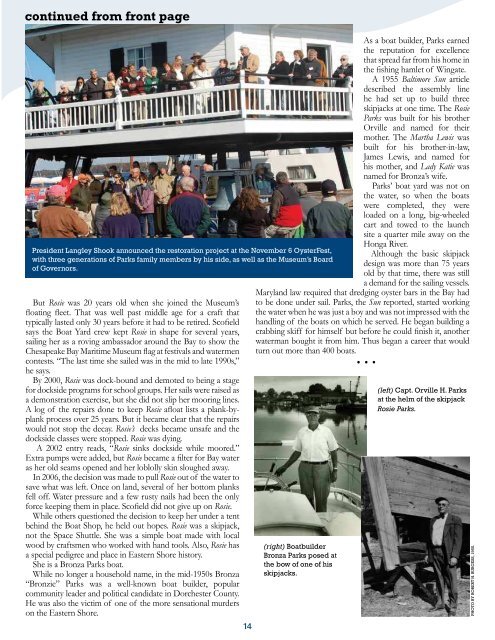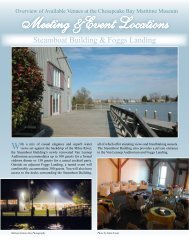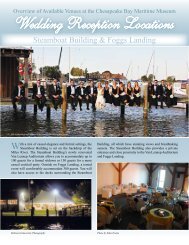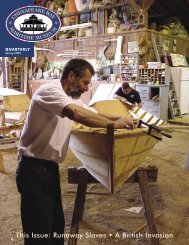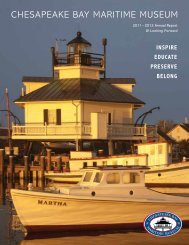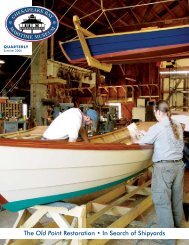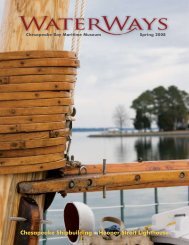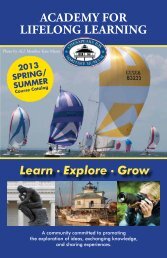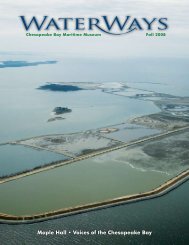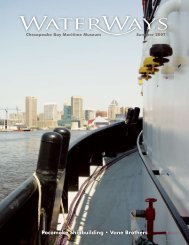Winter - Chesapeake Bay Maritime Museum
Winter - Chesapeake Bay Maritime Museum
Winter - Chesapeake Bay Maritime Museum
You also want an ePaper? Increase the reach of your titles
YUMPU automatically turns print PDFs into web optimized ePapers that Google loves.
continued from front page<br />
Feature<br />
President Langley Shook announced the restoration project at the November 6 OysterFest,<br />
with three generations of Parks family members by his side, as well as the <strong>Museum</strong>’s Board<br />
of Governors.<br />
But Rosie was 20 years old when she joined the <strong>Museum</strong>’s<br />
floating fleet. That was well past middle age for a craft that<br />
typically lasted only 30 years before it had to be retired. Scofield<br />
says the Boat Yard crew kept Rosie in shape for several years,<br />
sailing her as a roving ambassador around the <strong>Bay</strong> to show the<br />
<strong>Chesapeake</strong> <strong>Bay</strong> <strong>Maritime</strong> <strong>Museum</strong> flag at festivals and watermen<br />
contests. “The last time she sailed was in the mid to late 1990s,”<br />
he says.<br />
By 2000, Rosie was dock-bound and demoted to being a stage<br />
for dockside programs for school groups. Her sails were raised as<br />
a demonstration exercise, but she did not slip her mooring lines.<br />
A log of the repairs done to keep Rosie afloat lists a plank-byplank<br />
process over 25 years. But it became clear that the repairs<br />
would not stop the decay. Rosie’s decks became unsafe and the<br />
dockside classes were stopped. Rosie was dying.<br />
A 2002 entry reads, “Rosie sinks dockside while moored.”<br />
Extra pumps were added, but Rosie became a filter for <strong>Bay</strong> water<br />
as her old seams opened and her loblolly skin sloughed away.<br />
In 2006, the decision was made to pull Rosie out of the water to<br />
save what was left. Once on land, several of her bottom planks<br />
fell off. Water pressure and a few rusty nails had been the only<br />
force keeping them in place. Scofield did not give up on Rosie.<br />
While others questioned the decision to keep her under a tent<br />
behind the Boat Shop, he held out hopes. Rosie was a skipjack,<br />
not the Space Shuttle. She was a simple boat made with local<br />
wood by craftsmen who worked with hand tools. Also, Rosie has<br />
a special pedigree and place in Eastern Shore history.<br />
She is a Bronza Parks boat.<br />
While no longer a household name, in the mid-1950s Bronza<br />
“Bronzie” Parks was a well-known boat builder, popular<br />
community leader and political candidate in Dorchester County.<br />
He was also the victim of one of the more sensational murders<br />
on the Eastern Shore.<br />
As a boat builder, Parks earned<br />
the reputation for excellence<br />
that spread far from his home in<br />
the fishing hamlet of Wingate.<br />
A 1955 Baltimore Sun article<br />
described the assembly line<br />
he had set up to build three<br />
skipjacks at one time. The Rosie<br />
Parks was built for his brother<br />
Orville and named for their<br />
mother. The Martha Lewis was<br />
built for his brother-in-law,<br />
James Lewis, and named for<br />
his mother, and Lady Katie was<br />
named for Bronza’s wife.<br />
Parks’ boat yard was not on<br />
the water, so when the boats<br />
were completed, they were<br />
loaded on a long, big-wheeled<br />
cart and towed to the launch<br />
site a quarter mile away on the<br />
Honga River.<br />
Although the basic skipjack<br />
design was more than 75 years<br />
old by that time, there was still<br />
a demand for the sailing vessels.<br />
Maryland law required that dredging oyster bars in the <strong>Bay</strong> had<br />
to be done under sail. Parks, the Sun reported, started working<br />
the water when he was just a boy and was not impressed with the<br />
handling of the boats on which he served. He began building a<br />
crabbing skiff for himself but before he could finish it, another<br />
waterman bought it from him. Thus began a career that would<br />
turn out more than 400 boats.<br />
…<br />
(right) Boatbuilder<br />
Bronza Parks posed at<br />
the bow of one of his<br />
skipjacks.<br />
(left) Capt. Orville H. Parks<br />
at the helm of the skipjack<br />
Rosie Parks.<br />
PHOTO BY ROBERT H. BURGESS, 1955.<br />
In 1958, Bronza Parks was hired to build an 18-foot skiff by<br />
Willis C. Rowe of Silver Spring, Maryland. Rowe was a lawyer,<br />
researcher, and writer for the U.S. News & World Report magazine.<br />
On May 13, 1958, Rowe asked another legendary Eastern Shore<br />
boat builder, Captain Jim Richardson of the Neck District west<br />
of Cambridge, to go with him to Parks’ boat shop and inspect<br />
the skiff, according to original press reports researched by<br />
Dorchester County writer, Hal Roth.<br />
Richardson later testified in court that he waited outside the<br />
shop while Rowe went in to talk to Parks about payment. Three<br />
shots rang out. Richardson told a jury he reentered the shop and<br />
saw Parks on the floor, dead, and Rowe holding a revolver. Rowe<br />
was taken to Cambridge by the sheriff as a crowd of about 150<br />
Wingate residents gathered around the Parks shop. A mysterious<br />
fire destroyed the skiff.<br />
Rowe was held in state mental facilities for almost five years. In<br />
1963, he was convicted of second-degree murder and sentenced<br />
to 18 years in prison. The case was overturned by Maryland’s<br />
highest Court of Appeals because the jury found Rowe was<br />
sane when he shot Parks, but insane when he stood trial. He was<br />
retried and convicted in 1965.<br />
…<br />
Scofield says one of the goals of rebuilding the Rosie is so she can<br />
become a roving ambassador for the <strong>Museum</strong> and St. Michaels.<br />
The skipjack represents a key part of the <strong>Bay</strong>’s history. The lines<br />
for the Rosie were lifted in the late 1970s and the <strong>Museum</strong> has<br />
plans and dimensions to help with the reconstruction. Scofield<br />
says parts of the original keel, the transom and the stem may be<br />
saved and reused.<br />
14 15<br />
“We hope to involve area school children in the project,” he<br />
says. “I can see Tuesday and Thursday mornings working with<br />
kids on specific jobs.”<br />
Pres Harding, Bronza Parks’ grandson and a Chestertownbased<br />
musician, says the family is very excited about the project.<br />
“I was a young boy when those boats were built, but I remember<br />
all three of them in the yard,” he says.<br />
Harding’s musical group has performed at <strong>Museum</strong> events<br />
over the last two years. “I have to say, I was pretty shocked when<br />
I saw the condition Rosie is in,” he says. “This is a really good<br />
thing for the family and the <strong>Museum</strong>.”<br />
Three generations of the Parks family were at the <strong>Museum</strong><br />
when the rebuilding project was formally announced on<br />
November 6. Now deceased, Bronza was married to Katie<br />
Lewis and had five daughters – Lucille, Irene, twins Mary and<br />
Martha, and Joyce.<br />
Shook says he envisions the project as an ongoing exhibit.<br />
“Visitors will be able to return several times and watch<br />
the progress.”<br />
Photos from the <strong>Museum</strong> files show the skipjack in her prime.<br />
She is under sail, cutting through the water as white foam rushes<br />
from her stern. It is a majestic sight, a glimpse of the past and a<br />
look into the future when Rosie Parks returns to sail again, rebuilt<br />
and ready to rejoin the <strong>Bay</strong>’s skipjack fleet.<br />
-Dick Cooper is a Pulitzer Prize-winning career journalist with more<br />
than 35 years of daily newspaper experience. He was a reporter and<br />
editor at The Philadelphia Inquirer for 28 years before moving to<br />
St. Michaels, Maryland.<br />
PHOTO BY RILEY WALTER


